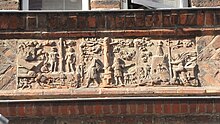Fleischhauerstrasse (Lübeck)

The Fleischhauerstraße ( Latin : Platea carnificum ) in the Johannis Quartier is one of the rib streets of the medieval town planning of Lübeck's old town.
history

Fleischhauerstraße is one of the oldest streets in Lübeck. Its name is explained by the fact that in the Middle Ages the meat processing professions were based in the street, to which the Küter, i.e. the butchers, and the butchers, namely the butchers , belonged. The Küter slaughtered the cattle in the Küterhaus , a structure built on stilts above the Wakenitz at the end of the Fleischhauerstrasse at the Kütertor , which was only demolished in 1876 and replaced by the slaughterhouse between Schwartauer Allee and Katharinenstrasse. The Kütergang (entrance at An der Mauer 12) is reminiscent of their apartments . The butchers processed the meat and sold it on the cupboard . Fleischhauer is the literal translation of the Latin name used in the first documented mention of the street in 1263. The same meaning as butcher is used as a job designation bone cutter , for example when it comes to the bone cutter revolt, which was borne by the residents of the street in 1384.
In addition to the meat processing companies, there were also 18 brewers in the street , who used the line leading through the street from the brewery water art , which was completed in 1294 .
The use of the street changed fundamentally with the introduction of the freedom of trade in 1867. The concentration of butchers dissolved and initially gave way to a large number of schools. Until 2002 the last Roßschlachterei Lübeck was in the lower block of the street . After a period of decline until the 1970s, retail dominates today. With the redesign of the middle part of the street by 2005, the city, the adjacent retail trade and the residents are trying to upgrade it as in the neighboring, parallel Hüxstraße .
course
Fleischhauerstrasse begins on Breiten Strasse opposite the Lübeck town hall . Its course, which leads from the ridge of the old town island to the east, down into the former valley of the Wakenitz , is divided into three parts. The upper one ends at Königstrasse . In this part, the historical development on the north side of the street was abandoned in the 1970s in favor of two new department stores or extensions (Anny Friede, Karstadt). To the east of Königstrasse, the Königspassage was created as a small shopping center on the former premises of the Lübecker Nachrichten . The middle part ends at the intersection with the streets Bei Johannis and Schlumacherstraße . The retail sector dominates here today. In the building at number 55–57, in a new building originally built between 1912 and 1914 for the AOK , the Turkish cultural center with mosque operated by the DİTİB is now located . On the lower part of the north on the site of the former Johanniskloster is the Johanneum . Opposite - in house no. 106 - there was Lübeck's last horse slaughterhouse until 2002 . To the east of it, the street ended earlier at the city wall of the Lübeck city fortifications and the Wakenitz, which enclosed Lübeck in the east until the Elbe-Lübeck Canal was dug at the end of the 19th century . Because the canal is narrower than the dammed Wakenitz was, land was won in the east of the "old town island", on which the canal road was laid, at which the Fleischhauerstrasse ends today.
People of the street
- Gustav Radbruch's parents' house was on Fleischhauerstrasse.
- Heinrich Waack, the rector of the city school (Fleischhauerstr. 73), lived in Fleischhauerstr. 71. Minna Rüdiger , one of his children, wrote the Lübeck novel Unforgottenes , published in 1904 . Along with Thomas Mann's Buddenbrooks and Ludwig Ewer's Grandfather City, this is one of the three most important Lübeck city novels.
Listed houses

Almost all of the houses on Fleischhauerstrasse are under monument protection . In the upper part, however, only houses on the right-hand side, numbers 6, 14, 16, 18. In the middle Fleischhauerstrasse, on the right-hand side, numbers 20 - 36, 40 - 44, 48 - 62, 74 - 82; on the left the numbers 25–37, 41–47, 61–67 (67: former Progymnasium and home of Otto Bussenius ), 71 - 89. In the lower part only the house 100/102 is under protection.
- See also the list of abandoned buildings in Lübeck for buildings that no longer exist.
Corridors and courtyards
The following two Lübeck corridors and courtyards started from Fleischhauerstraße (according to house numbers):
- 57: cemetery
- 100: Willrath Gang
literature
- Ulrich Büning: The Fleischhauerstrasse in Lübeck. Living and working from the Middle Ages to today. Documented by historical writings, finds, photos and drawings. Weiland, Lübeck 2005, ISBN 3-87890-100-3 .
Web links
Individual evidence
Coordinates: 53 ° 51 ′ 58.5 ″ N , 10 ° 41 ′ 27.4 ″ E


